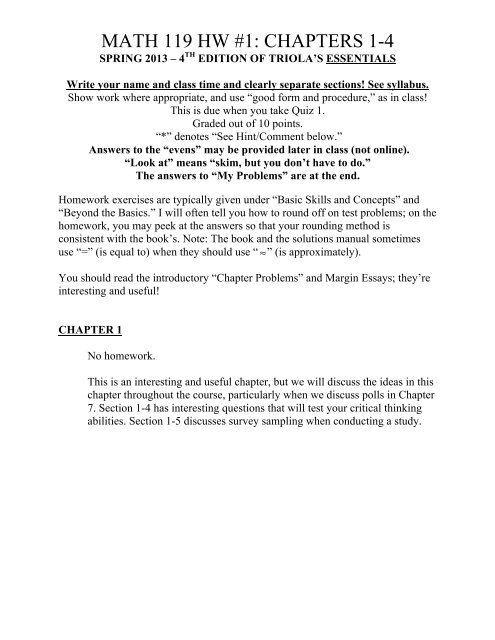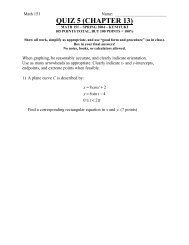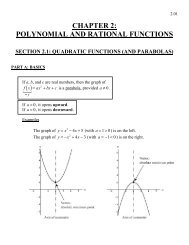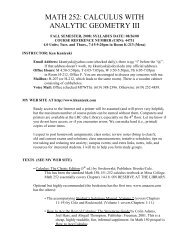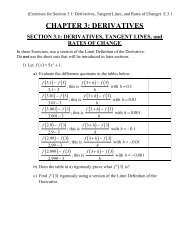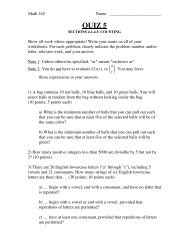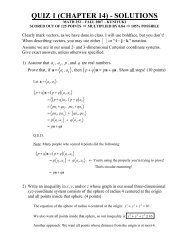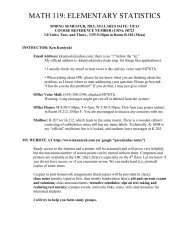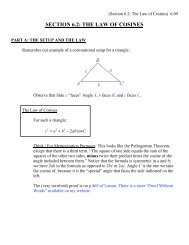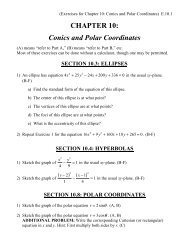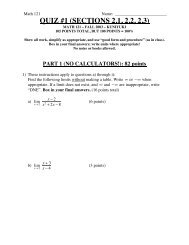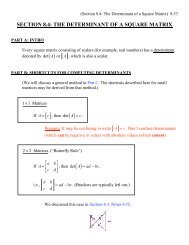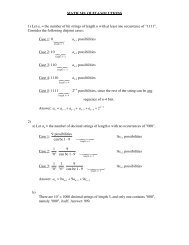MATH 119 HW #1: CHAPTERS 1-4 - Kkuniyuk.com
MATH 119 HW #1: CHAPTERS 1-4 - Kkuniyuk.com
MATH 119 HW #1: CHAPTERS 1-4 - Kkuniyuk.com
You also want an ePaper? Increase the reach of your titles
YUMPU automatically turns print PDFs into web optimized ePapers that Google loves.
<strong>MATH</strong> <strong>119</strong> <strong>HW</strong> <strong>#1</strong>: <strong>CHAPTERS</strong> 1-4<br />
SPRING 2013 – 4 TH EDITION OF TRIOLA’S ESSENTIALS<br />
Write your name and class time and clearly separate sections! See syllabus.<br />
Show work where appropriate, and use “good form and procedure,” as in class!<br />
This is due when you take Quiz 1.<br />
Graded out of 10 points.<br />
“*” denotes “See Hint/Comment below.”<br />
Answers to the “evens” may be provided later in class (not online).<br />
“Look at” means “skim, but you don’t have to do.”<br />
The answers to “My Problems” are at the end.<br />
Homework exercises are typically given under “Basic Skills and Concepts” and<br />
“Beyond the Basics.” I will often tell you how to round off on test problems; on the<br />
homework, you may peek at the answers so that your rounding method is<br />
consistent with the book’s. Note: The book and the solutions manual sometimes<br />
use “=” (is equal to) when they should use “ ≈” (is approximately).<br />
You should read the introductory “Chapter Problems” and Margin Essays; they’re<br />
interesting and useful!<br />
CHAPTER 1<br />
No homework.<br />
This is an interesting and useful chapter, but we will discuss the ideas in this<br />
chapter throughout the course, particularly when we discuss polls in Chapter<br />
7. Section 1-4 has interesting questions that will test your critical thinking<br />
abilities. Section 1-5 discusses survey sampling when conducting a study.
CHAPTER 2<br />
Section 2-2: #3, 11, 15, 19*<br />
On <strong>#1</strong>9, use the classes 1.0-1.1, 1.2-1.3, 1.4-1.5, 1.6-1.7, and 1.8-1.9<br />
(in mg).<br />
Look at (meaning skim these, but you don’t have to do these):<br />
<strong>#1</strong>7, 32.<br />
Section 2-3: #5*, 11*<br />
On #5, if you’re off by 1 or 2, that’s OK.<br />
On <strong>#1</strong>1, use your answer to 2-2, <strong>#1</strong>9, including the classes.<br />
Look at: #21.<br />
Section 2-4: #6, 13, 15<br />
On <strong>#1</strong>5, also give the corresponding percents and central angles.<br />
Look at: #3, 23, 27, 28.<br />
Section 2-5: No homework.<br />
If you enjoyed our discussion on the first day of class, you may want<br />
to skim this section on bad graphs.
CHAPTER 3<br />
Section 3-2: #4, 5*, 7*, 9*, 21, 29, 33<br />
Do: My Problem <strong>#1</strong><br />
All exams in Stan Marsh’s class are graded out of 100 points.<br />
Stan gets quiz grades of 65, 83, 80, and 90. He gets a 92 on his<br />
final exam. Find Stan’s weighted class average if the quizzes<br />
each count for 15% and the final counts for 40% of the overall<br />
grade. (The answer is given at the end of this assignment.)<br />
Do: My Problem #2<br />
So far, your grade record in a class looks like this:<br />
Exam % of overall<br />
grade<br />
Your score<br />
(out of 100)<br />
Quiz 1 10% 55<br />
Quiz 2 10% 50<br />
Midterm 1 20% 65<br />
Midterm 2 20% 40<br />
Final 40% a<br />
What must you get on the Final to get at least 70% in the class<br />
overall?<br />
Do: My Problem #3<br />
If every student in a class is given 10 extra points on a test,<br />
what happens to the mean, median, mode, and midrange of the<br />
test scores for the class?<br />
Read the Round-Off Rule on p.88 (which applies to Chapter 3, though<br />
we may alter them for later chapters). Remember that my test<br />
instructions always take precedence!<br />
Read Example 7 on pp.89-90.<br />
On #5, 7, 9: Read the instructions in blue for Exercises 5-20 above #5<br />
on p.94. Be prepared to look around the book like this for instructions<br />
on how to do problems!<br />
Look at: #8, 10, 12, 17. If you’re curious, look at 36-40 on other types<br />
of means.
Section 3-3: #3, 4, 5*, 18* (Hint: s ≈ 0.86 tons), 33, 34, 35, 36<br />
On #5, 18: Find s, not σ . The solutions manual uses a different<br />
formula from the one I used in class. There are some <strong>com</strong>putational<br />
advantages to the manual’s formula (Formula 3-5 on p.101), but it’s<br />
harder to remember and understand.<br />
Read the Round-Off Rule on p.100 (which applies to Chapter 3,<br />
though we may alter them for later chapters). My test instructions take<br />
precedence over everything.<br />
Note on pp.104-105: The Range Rule of Thumb is very rough. Do not<br />
use it on tests!<br />
Look at the coefficient of variation on pp.108-109.<br />
We will not be finding standard deviations from frequency tables.<br />
(Look at #29, 30.)<br />
Section 3-4: <strong>#1</strong>, 3, 4, 5, 9, 11, 13, 29* (boxplot only; see note below)<br />
On #29: Use the following 5-number summary. Min: 664, Q 1<br />
: 706,<br />
Median: 766, Q 3<br />
: 810, Max: 836.<br />
Do: My Problem #4<br />
Find the percentiles corresponding to the following deciles and<br />
quartiles: D 3<br />
, D 7<br />
, Q 1<br />
, and Q 3<br />
.<br />
Read: p.134 under Cooperative Group Activities on the anchoring effect in<br />
psychology.
CHAPTER 4<br />
Section 4-2: #2, 3, 13, 14, 15, 17, 19, 21, 25, 31, 33<br />
Do: My Problem #5<br />
All 50 students in a class arrive for a particular exam, but only<br />
40 of them arrive on time. What is the probability that a<br />
randomly selected student in the class arrives late to the exam?<br />
Read the rounding rules for these Ch.4 problems on p.145. Remember<br />
that my test instructions always take precedence!<br />
Look at the Roulette example on p.147. As always, look at the<br />
fascinating margin essays; several of these are on gambling here.<br />
Look at: #35.<br />
Section 4-3: #2, 5, 6, 7, 9, 11, 15, 17, 18, 19, 20, 31, 33, 35, 40<br />
Do: My Problem #6<br />
A gambler rolls a pair of standard dice. One die is colored red;<br />
the other is colored green.<br />
a) Find the probability that the red die will <strong>com</strong>e up “odd” or a<br />
“2.”<br />
b) Find the probability that the red die will <strong>com</strong>e up “odd” or<br />
the green die will <strong>com</strong>e up a “2.”<br />
Look at: #41, 42.
Section 4-4: #3, 4, 8, 9, 10, 12, 13, 21-27 all*<br />
Do: My Problem #7 (classic joke in academia)<br />
Five students arrive late for a test. They claim that they rode in<br />
the same (four-wheeled) car, and it blew a tire. The professor<br />
adds the following question to their tests before handing them<br />
out: “Which tire blew out?” Assuming that they are lying and<br />
they each choose the tire randomly, what is the probability that<br />
all five students pick the same tire?<br />
Do: My Problem #8 (the famous “Birthday Problem”!)<br />
If five people are randomly selected, find the probability that<br />
they have five different birthdays (i.e., no two people share the<br />
same birthday). Ignore leap years. We will do a related<br />
experiment in class!<br />
Do: My Problem #9<br />
A room has six Democrats and seven Republicans (and no one<br />
else). A reporter walks in and randomly selects three different<br />
people to interview, one-by-one. Find the probability that the<br />
interviewer selects two Democrats first and then a Republican.<br />
On #21-27 all: This means you do 21, 27, and all the problems in<br />
between. Also, on #25 and #26, see the margin essay on p.152. In<br />
spite of this, we will typically assume that boys and girls are equally<br />
likely among all births.<br />
Look at: #31.<br />
Section 4-5: #4, 5, 7, 9, 11, 13, 19, 20, 21<br />
Do: My Problem <strong>#1</strong>0 (tricky!)<br />
I flip two coins behind your back and tell you that at least one<br />
of the coins came up heads. What is the probability that both<br />
coins came up heads? Hint: Consider the sample space.<br />
Look at: <strong>#1</strong>6, 27, 29<br />
Section 4-6: Covered on the second homework assignment and quiz.<br />
Section 4-7: No homework.
Answers to My Problems<br />
<strong>#1</strong>: 84.5%<br />
#2: at least 97 points (round up)<br />
#3: They all increase by 10 points.<br />
#4: D 3<br />
= P 30<br />
, D 7<br />
= P 70<br />
, Q 1<br />
= P 25<br />
, and Q 3<br />
= P 75<br />
.<br />
#5: 1/5, or 0.200<br />
#6: a) 2/3, or about 0.667; b) 7/12, or about 0.583<br />
#7: 1/256, or about 0.00391<br />
#8: about 0.973<br />
#9: 35/286, or about 0.122<br />
<strong>#1</strong>0: 1/3


